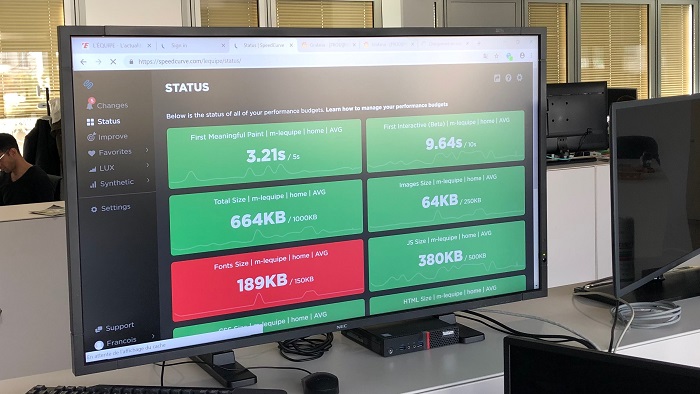Lequipe.fr has 1.5 billion page views every month, and between 2 and 3 million unique visitors every day. Optimizing loading times is a constant challenge.
In fact, as with an e-commerce site, a media outlet needs to attract and retain its readers, and this obviously requires a fluid UX and a fast site. So how do you evangelize about loading times internally? We spoke to François Boury, Internet Technical Director at lequipe.fr, who explains the organization and tools used to raise awareness of the importance of loading times.
How do the technical teams work to guarantee fast loading times on lequipe.fr?
François Boury: Lequipe.fr is a high-traffic site: lots of visitors, high bandwidth requirements, many competing media sites… All IT teams are concerned with loading times, both Front-End and Back-End. For each development, we ask ourselves if it’s efficient and economical – it’s an established reflex.
We implement tried-and-tested best practices: using a CDN, minifying and compressing CSS, JS and images… Every byte saved counts.
I think it’s really the role of developers to keep these notions in mind, because mastering JS frameworks and webperf are an integral part of their job.
We’ve chosen not to dedicate a specific team to webperf, simply because the whole IT department is involved. Each team member is trained in webperf and follows best practices, as well as receiving regular training from experts.
To ensure continuity in the transmission of knowledge and skills, we carry out Code Reviews which are the subject of shared feedback, and we keep our documentation on webperf best practices up to date internally.
Have you gone through a reorganization phase to integrate webperf into the work habits of your IT teams?
F.B.: My aim is to ensure that every developer is aware of webperf and has the right reflexes. So we haven’t reorganized our technical teams, but we’ve been sharing our knowledge and expertise for several years now. This approach is bearing fruit, as the time spent on webperf optimizations is becoming relatively marginal.
For example, every new site launch triggers a WebPageTest , which provides a summary of optimization points, and all Front developers are informed to check what can be improved. Webperf is also one of the criteria taken into account in the early stages of new product development.
Given that webperf work has to be constant to benefit from lasting effects, how do you monitor your loading times on an ongoing basis?
As many companies are setting up “Social Rooms”, we’ve installed a screen in our offices which continuously displays load times for both desktop and mobile versions of our site. It displays the key indicators for both technical and business teams, which contributes to internal evangelization.
How do you coordinate with other teams?
F. B. : Just as we train the technical teams, we also make the product and marketing teams aware of the importance of web performance. There’s a lot of emulation between media sites, and we all need to be aware that a fast, high-performance site helps us to position ourselves against the competition with a quality product.
That’s why we’ve also been educating people internally about the notion of performance budgeting, which we share with our business teams. For example, we have special fonts that carry a certain weight, and as we are obliged to use them to ensure consistency between the print edition, the website and TV, we have to take this into account in the optimizations we deploy.
Externally, if resources need to be added to the site, we may decide not to deploy them if they are too cumbersome. As for Third Parties, all new partners must guarantee that their scripts can be loaded asynchronously, that JS respects certain standards, that they do not exceed a maximum size for cookies… This ensures that these Third Parties will not degrade our performance, and these constraints are generally well received.
We worked on the redesign of the mobile site in Progressive Web App in 2017, whose performance serves as a starting point for us to work on the future version.
In the future, our aim is obviously to further improve loading times, by equipping ourselves with a new JS framework, a new architecture and by pushing optimizations even further :
- switching from Angular to the lighter Vue.js
- use of code splitting to load only the CSS and JS required on a page
- prerendering for both search engines and web users
- adapting image quality and filtering certain JS scripts according to connection quality
Thanks to these best practices, we hope to gain 1 second in Speed Index!
Would you like to find out more about how to improve your loading times?
Download our white paper :












